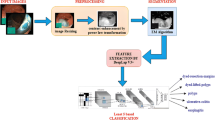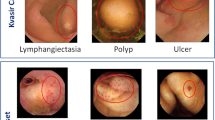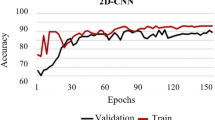Abstract
Wireless capsule endoscopy is a non-invasive and painless procedure to examine the gastrointestinal tract of human body, and an experienced clinician takes 2–3 hours for complete examination. To reduce this diagnosis time, the present work proposes a lightweight CNN model for binary classification of WCE images. The proposed model has a strong backbone of CNN in the primary branch complemented by resolution preserving dilated convolution layers in secondary branches. The proposed model extracts multiple features at different scales and finally fuses them together to fetch the dominant global feature that aids in binary classification problem. A new dataset has been created in collaboration with All India Institute of Medical Sciences, Delhi. The efficacy of the proposed model has been verified using the developed dataset using various subjective and objective parameters. Feature maps generated at each branch have been thoroughly analyzed to understand the quality of learning. Thorough experimental analysis indicates that the proposed model yields an accuracy of 0.96, sensitivity of 0.93 and specificity of 0.97 on real data collected from AIIMS Delhi. To verify the efficacy of the proposed dilated CNN, extensive analysis has been done using standard KID dataset as well. For a fair comparison, these datasets have also been used for pre-trained inception net model. Thorough analysis indicates that the proposed architecture performs well both for AIIMS dataset and the standard KID dataset. Result analysis also reflects that the proposed dilated CNN architecture outperforms the performance of pre-trained inception net model.










Similar content being viewed by others
Data availability
KID dataset is publically available, AIIMS dataset is a private dataset currently.
References
Alaskar H, Hussain A, Al-Aseem N, Liatsis P, Al-Jumeily D (2019) Application of convolutional neural networks for automated ulcer detection in wireless capsule endoscopy images. Sensors 19(6)
Aoki T, et al (2019) Automatic detection of erosions and ulcerations in wireless capsule endoscopy images based on a deep convolutional neural network. Gastrointestinal Endoscopy 89(2) pp 357–363
Charfi S, El AM, Balasingham I (2019) Computer-aided diagnosis system for ulcer detection in wireless capsule endoscopy images. IET Image Process 13(6):1023–1030, 5, 10.1049/iet-ipr.2018.6232
Diamantis DE, Iakovidis DK, Koulaouzidis A (2019) Look-behind fully convolutional neural network for computer-aided endoscopy. Biomed Signal Process Control 49:192–201. https://doi.org/10.1016/j.bspc.2018.12.005
Fu Y, Zhang W, Mandal M, Meng MQ-H (2014) Computer-aided bleeding detection in WCE video. IEEE J Biomed Health Informat 18(2):636–642. https://doi.org/10.1109/JBHI.2013.2257819
Gunjan D, Sharma V, Rana SS, Bhasin DK (2014) Small bowel bleeding: a comprehensive review. Gastroenterol Rep (Oxf) 2(4):262–275. https://doi.org/10.1093/gastro/gou025
Hajabdollahia M, Esfandiarpoora R, Sabetib E, Karimia N, Soroushmehrc SMR, Samavid S (2020) Multiple abnormality detection for automatic medical image diagnosis using bifurcated convolutional neural network. Biomed Signal Process Control 57:1–10. https://doi.org/10.1016/j.bspc.2019.10179
Hamaguchi R, Fujita A, Nemoto K, Imaizumi T, Hikosaka S (2018) Effective use of dilated convolutions for segmenting small object instances in remote sensing imagery. In: IEEE winter conference on applications of computer vision (WACV), NV, , pp 1442-1450, https://doi.org/10.1109/WACV.2018.00162.
He JY, Wu X, Jiang YG, Peng Q, Jain R (2018) Hookworm detection in wireless capsule endoscopy images with deep learning. IEEE Trans Image Process 27(5):2379–2392. https://doi.org/10.1109/TIP.2018.2801119
Hwang S (2011) Bag-of-visual-words approach to abnormal image detection in wireless capsule endoscopy videos. In: Advances in visual computing, Springer, pp 320–327. https://doi.org/10.1007/978-3-642-24031-7_32
Iakovidis Dimitris K, Anastasios Koulaouzidis (2014) Automatic lesion detection in capsule endoscopy based on color saliency: closer to an essential adjunct for reviewing software. Gastrointestinal Endoscopy 80(5):877–83
Iakovidis DK, Georgakopoulos SV, Vasilakakis M, Koulaouzidis A, Plagianakos VP (2018) Detecting and locating gastrointestinal anomalies using deep learning and iterative cluster unification. IEEE Trans Med Imaging 37(10):2196–2210. https://doi.org/10.1109/TMI.2018.2837002
Iddan G, Meron G, Glukhovsky A, Swain P (2000) Wireless capsule endoscopy. Nature 405
Jia X, Meng MQ-H (2016) A deep convolutional neural network for bleeding detection in wireless capsule endoscopy images. \(38^{th}\) Ann Int Conf IEEE Eng Med Biol Soc (EMBC), pp 639–642. http://dx.doi.org/10.1109/EMBC.2016.7590783
Kaur S, Goel N (2020) A dilated convolutional approach for inflammatory lesion detection using multi-scale input feature fusion (Workshop Paper). In: IEEE international conference on big multimedia data, New Delhi, India, pp 386–393, https://doi.org/10.1109/BigMM50055.2020.00066.
Koulaouzidis A, Iakovidis DK, Karargyris A, Plevris JN (2014) Optimizing lesion detection in small-bowel capsule endoscopy: from present problems to future solutions. Expert Rev Gastroenterol Hepatol 9(2):217–235. https://doi.org/10.1586/17474124.2014.952281
LeCun Y, Haffner P, Bottou L Bengio Y (1999) Object recognition with gradient-based learning. In: Shape, contour and grouping in computer vision. 1681(7), pp 319–345
Li B, Meng M-H (2012) Tumor recognition in wireless capsule endoscopy images using textural features and svm-based feature selection. IEEE Trans Inf Technol Biomed 16(3):323–329. https://doi.org/10.1109/TITB.2012.2185807
Liang M, Hu X, Zhang B (2015) Convolutional neural networks with intra-layer recurrent connections for scene labeling. In: Cortes C, Lawrence ND, Lee DD, Sugiyama M, Garnett R (eds). Advances in neural information processing systems 28, pp 937–945
Liu J, Yuan X (2008) Obscure bleeding detection in endoscopy images using support vector machines. Optim Eng 10(2):289–299
Nawarathna R et al (2014) Abnormal image detection in endoscopy videos using a filter bank and local binary patterns. Neurocomputing 144:70–91. https://doi.org/10.1016/j.neucom.2014.02.064
Rajagopalan SS, Rice SC, Slawinski PR, Valdastri P, Obstein KL (2019) Evaluation of an automated lesion detection platform for wireless capsule endoscopy: a novel approach utilizing video-based machine learning temporal relationships. Gastrointestinal Endoscop 89(6)
Saito H, et al (2020) Automatic detection and classification of protruding lesions in wireless capsule endoscopy images based on a deep convolutional neural network. Gastrointestinal Endoscopy 92(1):144-151
Seguí S, Drozdzal M, Pascual G, Radeva P, Malagelada C, Azpiroz F, Vitrià J (2016) Generic feature learning for wireless capsule endoscopy analysis. Comput Biol Med 79:163–172. https://doi.org/10.1016/j.compbiomed.2016.10.011
Sekuboyina AK, Devarakonda ST, Seelamantula CS (2017) A convolutional neural network approach for abnormality detection in wireless capsule endoscopy. In: IEEE \(14^{th}\) international symposium on biomedical imaging (ISBI (2017) Melbourne. VIC 2017:1057–1060. https://doi.org/10.1109/ISBI.2017.7950698
Shen L, Shan Y-S, Hu H-M et al (2013) Management of gastric cancer in Asia: resource-stratified guidelines. Lancet Oncol 14(12):535–547
Yuan Y, Li B, Meng Q (2016) Bleeding frame and region detection in the wireless capsule endoscopy video. IEEE J Biomed Health Inform 20(2):624–630. https://doi.org/10.1109/JBHI.2015.2399502
Yuan Y, Li B, Meng MQ (2016) Improved bag of feature for automatic polyp detection in wireless capsule endoscopy images. IEEE Trans Autom Sci Eng 13(2):529–535. https://doi.org/10.1109/TASE.2015.2395429
Yuan Y, Li B, Meng MQ (2017) WCE abnormality detection based on saliency and adaptive locality-constrained linear coding. IEEE Trans Autom Sci Eng 14(1):149–159. https://doi.org/10.1109/TASE.2016.2610579
Yu F, Koltun V (2016) Multi-scale context aggregation by dilated convolutions. In: International conference on learning representations
Zhang R, Zheng Y, Mak TWC, Yu R, Wong SH, Lau JYW, Poon CCY (2017) Automatic detection and classification of colorectal polyps by transferringlow-level CNN features from nonmedical domain. IEEE J Biomed Health Inform 21:41–47. https://doi.org/10.1109/JBHI.2016.2635662
Zhang Yuqian, Li Guohui, Lei Jun, He Jiayu (2019) FDCNet: frontend-backend fusion dilated network through channel-attention mechanism. Appl Sci 9(17):3466
Acknowledgements
The authors would like to express their sincere gratitude toward Dr Pramod K Garg, Professor, Department of Gastroenterology, All India Institute of Medical Sciences, New Delhi for his expert guidance and inputs. The authors also acknowledge the support from SMDP-C2SD project funded by Ministry of Electronics and Information Technology, Government of India for the research grant.
Funding
SMDP-C2SD project funded by Ministry of Electronics and Information Technology, Government of India.
Author information
Authors and Affiliations
Ethics declarations
Conflict of interest
The authors have no conflicts of interest to declare.
Additional information
Publisher's Note
Springer Nature remains neutral with regard to jurisdictional claims in published maps and institutional affiliations.
This work was supported by SMDP-C2SD Project funded by Ministry of Electronics and Information Technology, Government of India.
Rights and permissions
About this article
Cite this article
Goel, N., Kaur, S., Gunjan, D. et al. Dilated CNN for abnormality detection in wireless capsule endoscopy images. Soft Comput 26, 1231–1247 (2022). https://doi.org/10.1007/s00500-021-06546-y
Accepted:
Published:
Issue Date:
DOI: https://doi.org/10.1007/s00500-021-06546-y




